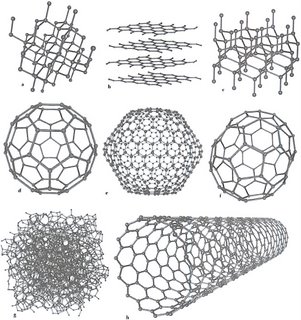As well, this takes us back to the article from Backreaction. This post was generated in response to Q's comment and my subsequent statements that I supplied in turn.
Take "full note of Fermion" discription here, as well as, theoretical understanding implied.
Just to note now that the widget on right called Dialogue of Ideas(Dialogos of Eide)supplies the ability to "rightclick" on name and then copy/paste to box ability. This enhances location and response, that you may have further to any topic.
In this regard, Paul's thoughts on the "Reimann Hypothesis" enters here and the undertsanding that this gave to computerized processes the ability to see ULam as the developemental attitude/geometry of the Carbon, which takes on new allotropic forms.

This illustration depicts eight of the allotropes (different molecular configurations) that pure carbon can take:
a) Diamond
b) Graphite
c) Lonsdaleite
d) Buckminsterfullerene (C60)
e) C540
f) C70
g) Amorphous carbon
h) single-walled carbon nanotube
Review of experiments
Graphite exhibits elastic behaviour and even improves its mechanical strength up to the temperature of about 2500 K. Measured changes in ultrasonic velocity in graphite after high temperature creep shows marked plasticity at temperatures above 2200 K [16]. From the standpoint of thermodynamics, melting is a phase transition of the first kind, with an abrupt enthalpy change constituting the heat of melting. Therefore, any experimental proof of melting is associated with direct recording of the temperature dependence of enthalpy in the neighbourhood of a melting point. Pulsed heating of carbon materials was studied experimentally by transient electrical resistance and arc discharge techniques, in millisecond and microsecond time regime (see, e.g., [17, 18]), and by pulsed laser heating, in microsecond, nanosecond and picosecond time regime (see, e.g., [11, 19, 20]). Both kind of experiments recorded significant changes in the material properties (density, electrical and thermal conductivity, reflectivity, etc. ) within the range 4000-5000 K, interpreted as a phase change to a liquid state. The results of graphite irradiation by lasers suggest [11] that there is at least a small range of temperatures for which liquid carbon can exist at pressure as low as 0.01 GPa. The phase boundaries between graphite and liquid were investigated experimentally and defined fairly well.
Ray of Creation
It is the "archetectual building" that goes on that we may discern the inherent nature of our pursuites? "Ray of creation," is explicit here, in terms of how such building will go on with photonic formation technologies. While imnde th weight of ole structure the sarches hold up an extreme beauty of the churches design? Gravity weight's down with it's burden?:)
Courtesy Edgar Fahs Smith Memorial Collection, Department of Special Collections, University of Pennsylvania Library
Mendeleev's world come true, as we think about the "Rainbow of possibilites" in our spectrum, as well as develope the "basis of perception" that grew from "thematic realizations" from our brightest minds?? Carbon based societies, or further geometrics that remain elusive to us??
So what about the geometrics of all this processing? Our pursuites to Gluonic perceptions where such high energy photons will deliver us informative stylizations to the early events in the cosmo? Angle of perpeptions exist, and what does it say about the photon?
Carbon forms the backbone of biology for all life on Earth. Complex molecules are made up of carbon bonded with other elements, especially oxygen, hydrogen and nitrogen. It is these elements that living organisms need, among others, and carbon is able to bond with all of these because of its four valence electrons. Since no life has been observed that is not carbon-based, it is sometimes assumed in astrobiology that life elsewhere in the universe will also be carbon-based. This assumption is referred to by critics as carbon chauvinism, as it may be possible for life to form that is not based on carbon, even though it has never been observed.
"Carbon" at the very beginning of the birthing process? Maybe, just in this universe of ours?:)While, moving to the "photonic base" we delve into the spiritual implications of the "observer's choice" of materiality as a "mass enhancement" of our reasoning?
Carbon was not created during the Big Bang due to the fact that it needs a triple collision of alpha particles (helium nuclei) to be produced. The universe initially expanded and cooled too fast for that to be possible. It is produced, however, in the interior of stars in the horizontal branch, where stars transform a helium core into carbon by means of the triple-alpha process. It was also created in a multi-atomic state
So some will not like the "tunes we play," "the concepts" or the "model enhancements" that are less then "the Theory" that Hooft tells us about in his comments in Lee Smolin's book.
So, we are left with the artistically inclined and those whose "thematic" realizations require them to explain to us this anomalistical nature that apparently is waiting out there for us. It is that we just have to discover/remember it?
But until then, we are supposed to be doing science? Ahem! Apparently, we had be doing naught?:)
I then dream.....:)

No comments:
Post a Comment